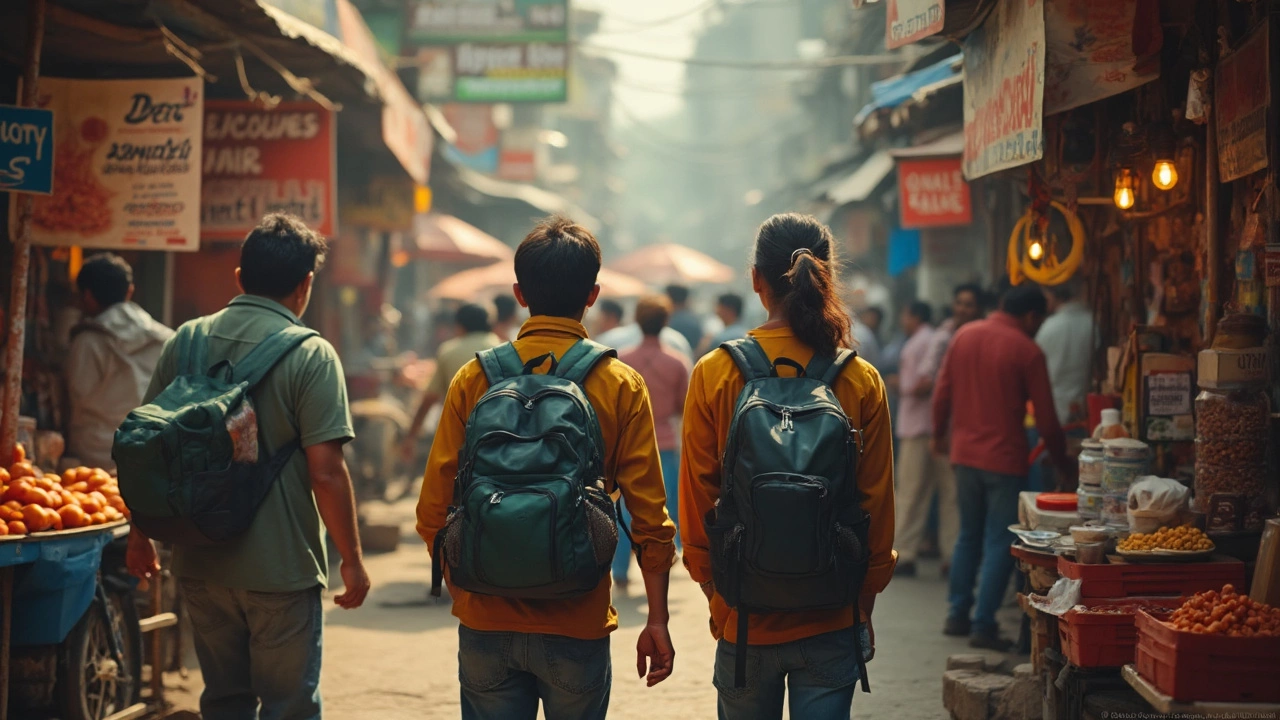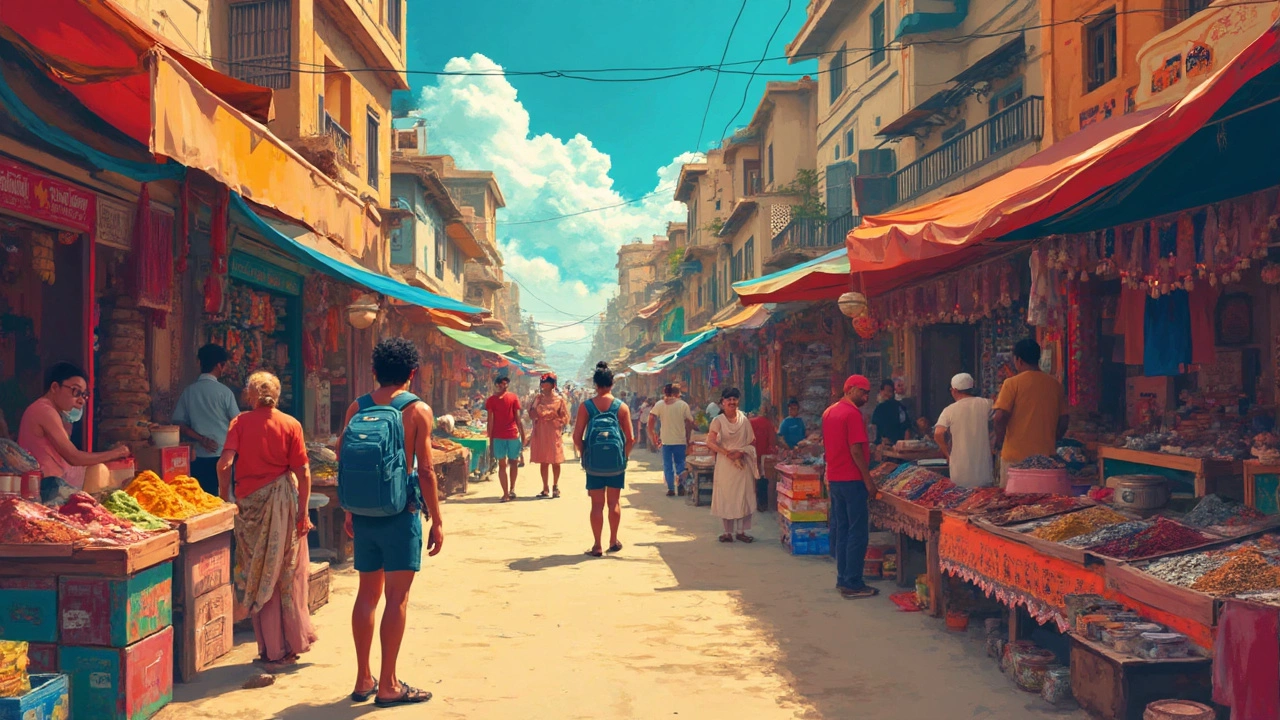How Far Does 500 Rupees Go in India? Budget Travel Guide
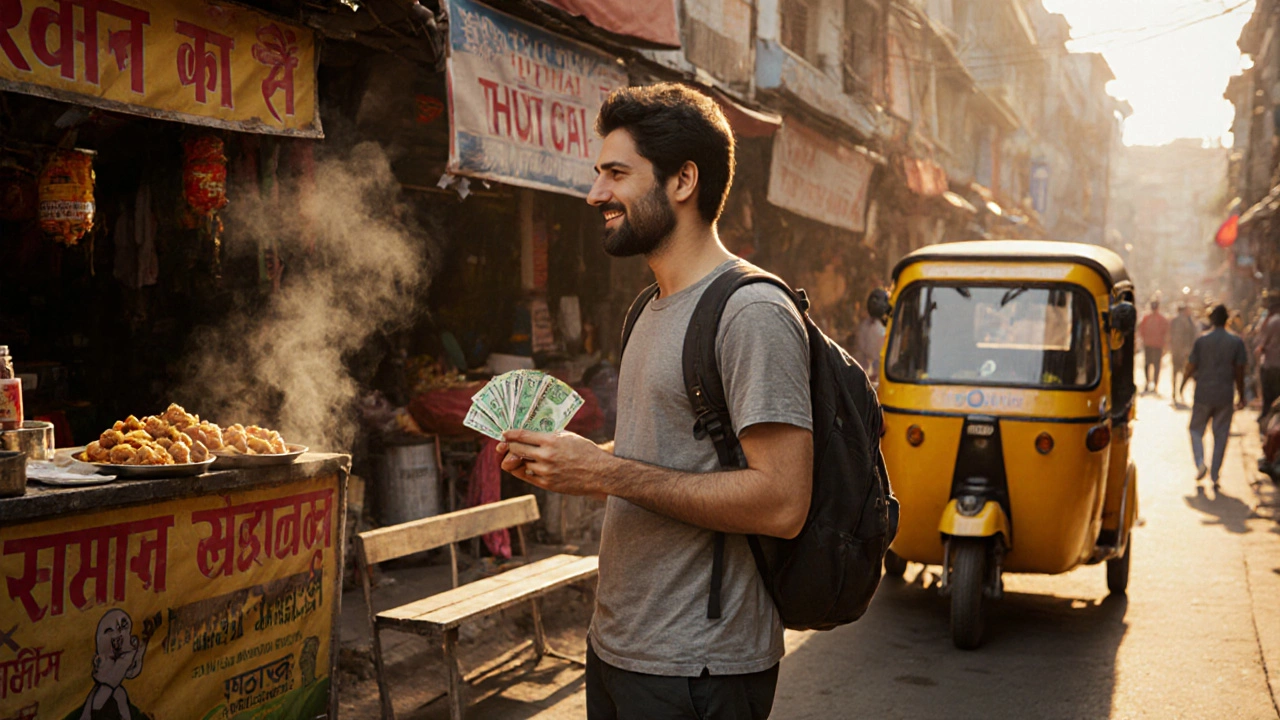
India Budget Travel Calculator
How far does 500 rupees go?
Find out what 500 rupees (approx. $6 USD) can cover for your travel in different Indian cities.
Your Budget Breakdown
What This Budget Covers
Your 500 rupees budget covers basic travel needs in this city, including a meal, transport, and a night's accommodation.
Key Takeaways
- 500rupees (≈$6USD in 2025) can cover a modest meal, short bus ride, or a night in a budget hostel in most Indian cities.
- In metro areas like Mumbai or Delhi, the same amount buys less than in smaller towns or rural regions.
- Understanding local pricing (street food, shared transport, dorm beds) lets you stretch every rupee.
- Average daily wages in India are around 650rupees, so a traveller’s 500rupees is comparable to a half‑day’s earnings for many locals.
- Smart budgeting (e.g., using rail passes, eating at dhabas, staying in guesthouses) can make 500rupees last 2-3 days.
When you hear a traveller ask, “Is 500 rupees a lot in India?”, the answer depends on where you are, what you need, and how you spend it. 500 Indian Rupees is a unit of currency that, in October2025, converts to roughly $6USD. It’s enough for a simple breakfast, a short auto‑rickshaw ride, or a night in a shared dorm. Below we break down the buying power of that amount, compare it to local wages, and give you practical tips to make it stretch across India’s diverse regions.
What Does 500 Rupees Actually Buy?
The first step is to look at everyday items. Prices vary by city, but most budget‑travelers will encounter similar ranges:
- Street food: A plate of panipuri, a bowl of masalavada, or a serving of chicken boti roll typically costs 30‑80rupees.
- Public transport: City bus tickets run 10‑25rupees; a shared auto‑rickshaw ride of 5km costs about 40‑60rupees. Metro fares in Delhi or Mumbai start at 20rupees and rise with distance.
- Accommodation: In hostels, a bunk in a dormitory ranges from 350‑600rupees per night in major cities, while Guesthouses in smaller towns can be as low as 250rupees.
- Bottled water (1L): 15‑30rupees.
- Tea/coffee at a street stall: 10‑20rupees.
By adding a few of these items together, you can see that 500rupees often covers a full day’s basic needs for a solo traveller.
Cost of Living vs. Average Income
To gauge whether 500rupees feels “a lot”, compare it with the average earnings of an Indian worker. According to the Ministry of Labour’s 2024 report, the mean daily wage for unskilled labor is about 650rupees, while skilled labor averages 1,200rupees per day. That means 500rupees is roughly 77% of a day’s earnings for many low‑skill workers and about 42% for a skilled worker.
Inflation has been modest this year, with the Consumer Price Index at 5.2% YoY. The rupee’s exchange rate against the US dollar has hovered around 83rupees per dollar, making 500rupees equal to $6.02. For most foreign visitors, it’s a modest amount, but for locals it represents a sizable portion of a daily income.
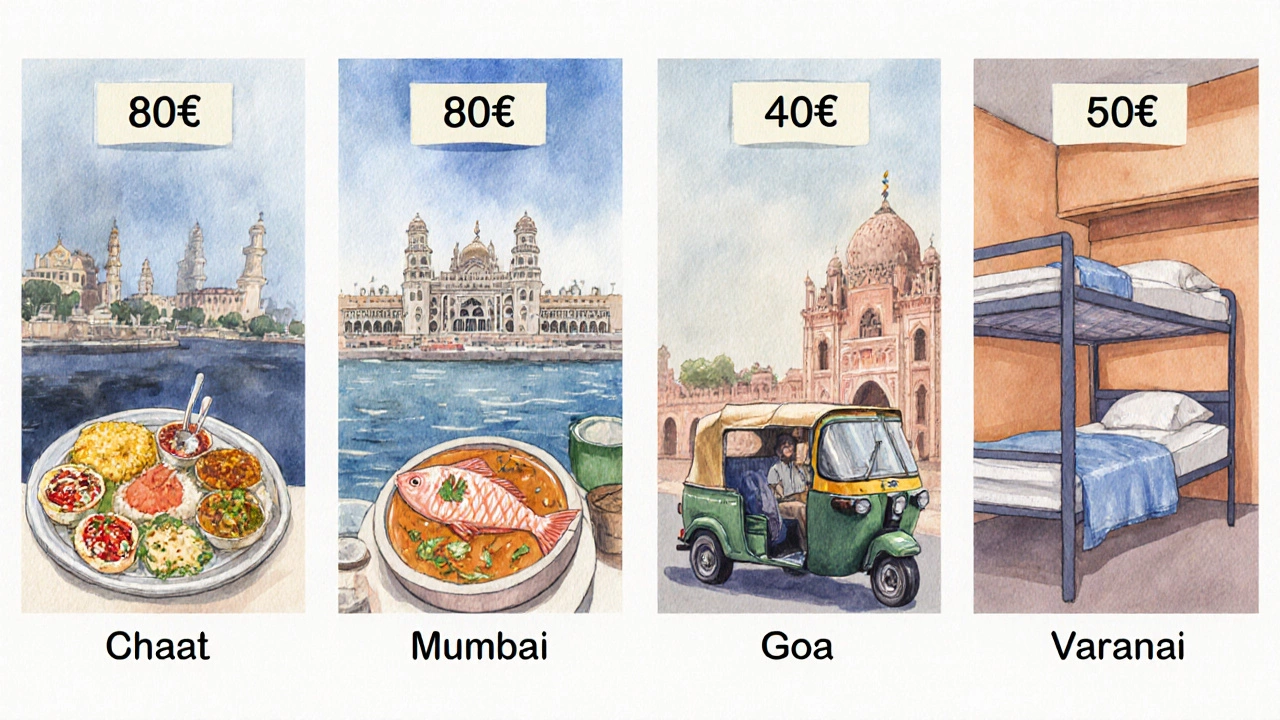
Metro Cities vs. Smaller Towns
India’s cost landscape is uneven. In Mumbai, the financial capital, a dorm bed costs 550‑650rupees, while a simple dal‑rice meal at a canteen can be 120‑150rupees. In contrast, in a town like Mysore or Varanasi, the same bed might be 300‑350rupees and a plate of thali 70‑90rupees.
Below is a quick snapshot of what 500rupees can buy in four representative locations:
| City | Typical Meal | Transport (5km) | Hostel Bed (per night) | What’s Left? |
|---|---|---|---|---|
| Delhi | 80rupees (street chaat) | 40rupees (auto‑rickshaw) | 450rupees | 30rupees (water) |
| Mumbai | 120rupees (veg thali) | 50rupees (bus) | 550rupees | Insufficient for a night stay |
| Goa (tourist hub) | 100rupees (fish curry rice) | 30rupees (local bus) | 400rupees | 0rupees (exact fit) |
| Varanasi | 70rupees (kachaudi‑sabzi) | 20rupees (rickshaw) | 300rupees | 110rupees (snacks) |
Tips to Stretch 500 Rupees Further
- Eat where locals eat: Street stalls, dhabas, and university canteens offer filling meals for 30‑80rupees. Avoid tourist‑focused restaurants that charge 3‑4× more.
- Use shared transport: Auto‑rickshaws with multiple passengers split the fare, bringing a 5km ride down to 15‑20rupees per person.
- Book hostels in advance: Many chains (e.g., Zostel, Hostelworld) provide discounts for early online bookings, often dropping the price to 300‑350rupees even in Delhi.
- Carry a refillable water bottle: Buying large bottles (1L) costs 15‑20rupees, while refill stations are free at many restaurants.
- Leverage rail passes: For inter‑city travel, the Indian Railways’ “Unreserved Ticket” can be as low as 150rupees for 200km, leaving more cash for local needs.
- Shop at local markets: Fresh fruit, peanuts, and tea leaves bought in bulk can provide snacks for under 10rupees each.
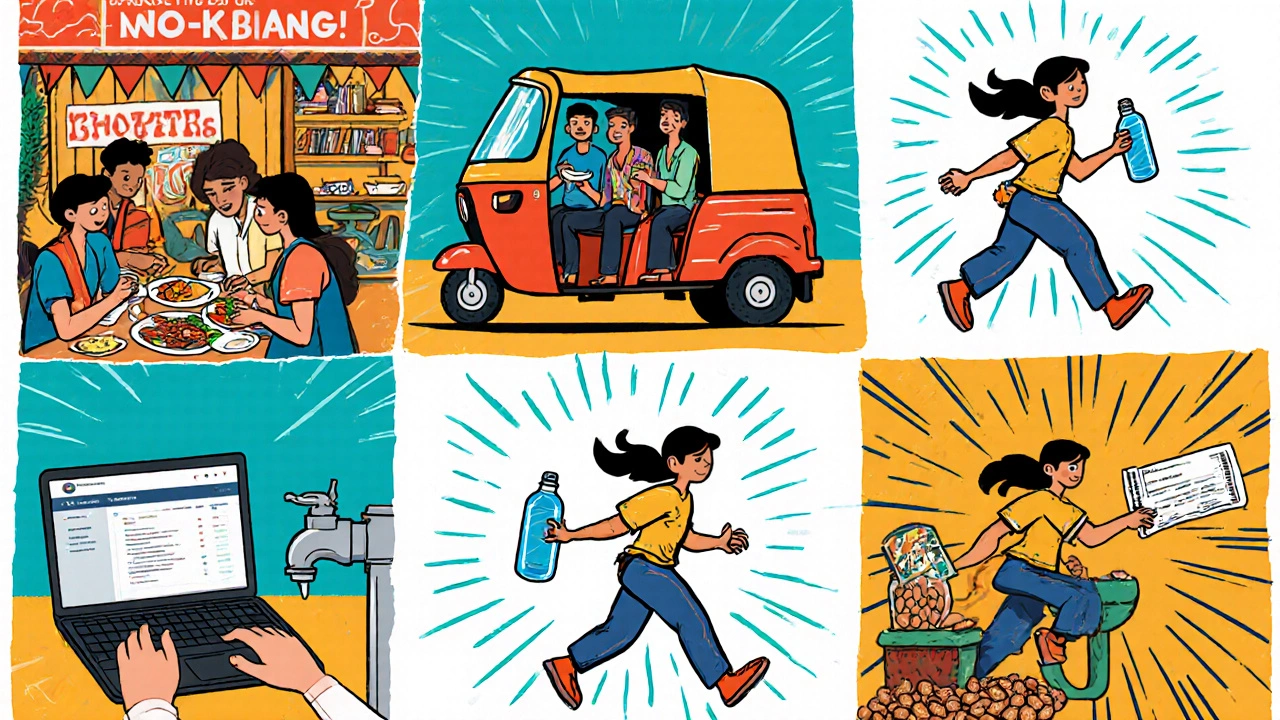
Common Misconceptions About 500 Rupees
Myth 1: 500rupees is enough for a “luxury” experience.
Reality: Luxury hotels, fine‑dining, and private taxis start at 2,000rupees and quickly exceed a modest budget.
Myth 2: Prices are the same everywhere.
Reality: Tourist hot‑spots often inflate costs by 20‑30% compared to nearby towns.
Myth 3: You can’t use 500rupees for sightseeing.
Reality: Many museums and heritage sites have entry fees of 20‑100rupees, leaving plenty for transport and food.
Quick Budget Checklist for 500Rupees
- Meal: 1‑2 street dishes (30‑80rupees each)
- Transport: 1‑2 short rides (20‑50rupees each)
- Accommodation: 1 night in a dorm (350‑500rupees)
- Extras: Water, tea, small snack (10‑30rupees)
Adjust the numbers based on city tier - metros will push the accommodation cost higher, while small towns let you save.
Frequently Asked Questions
How far does 500 rupees go in Delhi?
In Delhi, 500rupees can comfortably cover a street‑food meal (≈80rupees), a 5km auto‑rickshaw ride (≈40rupees), and a night in a budget hostel (≈350‑400rupees). You’ll have a few rupees left for water or a tea.
Can I travel between cities on a 500‑rupee budget?
Yes, if you use Indian Railways’ unreserved tickets or state‑run buses. A 200‑km train ride can be as cheap as 150rupees, leaving 350rupees for food and local transport at the destination.
Is 500 rupees enough for a vegetarian meal in Mumbai?
A simple veg thali at a local canteen costs 100‑130rupees. Pair it with a small snack and you’re still well under 500rupees, but a hostel bed may cost 550rupees, so you’d need a cheaper dorm or a night’s stay elsewhere.
How does 500 rupees compare to the average daily wage?
The average unskilled daily wage in India is about 650rupees, so 500rupees equals roughly 77% of a day’s earnings for that group. For skilled workers earning 1,200rupees, it’s about 42%.
What’s the best way to save money on transport?
Opt for shared auto‑rickshaws, city buses, and, for longer trips, unreserved rail tickets. Many cities also offer day passes (≈150‑200rupees) that let you ride unlimited times.
Bottom line: 500rupees is modest but not meaningless. It can cover the basics of a day’s travel in most parts of India, especially if you stick to local options and plan ahead. Treat it as a “budget baseline” and adjust based on city, travel style, and personal comfort level.
